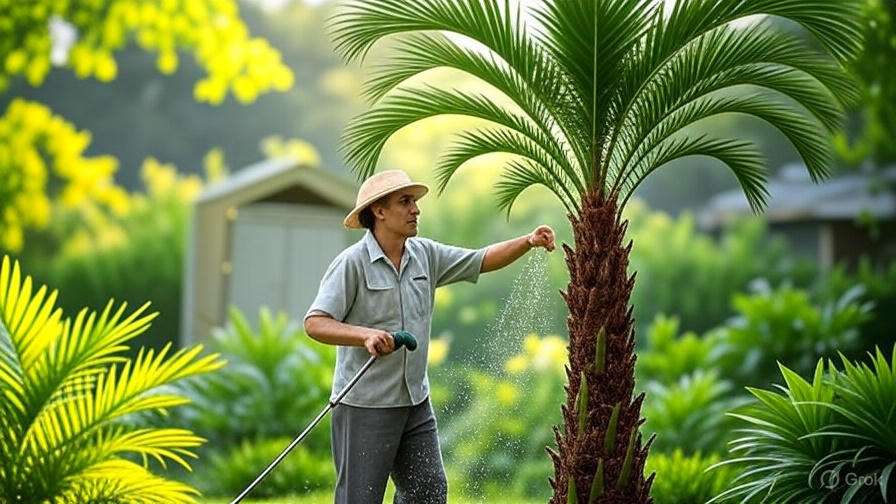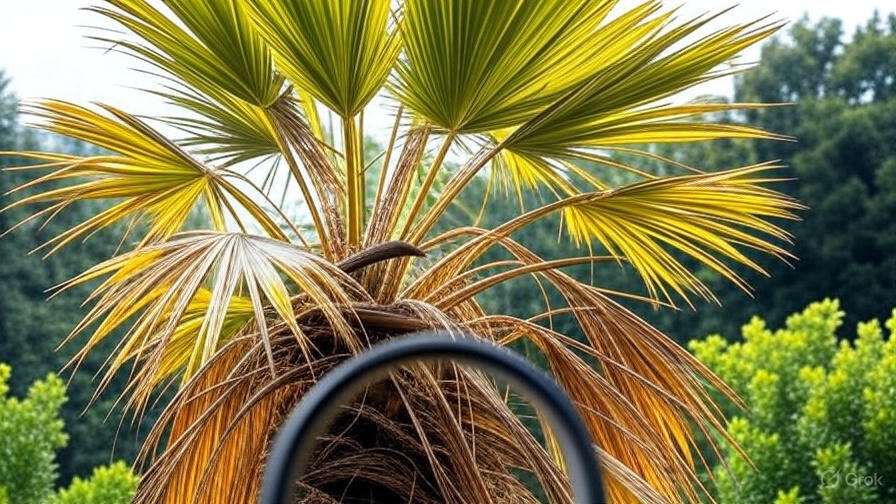
How Fast Do Palm Trees Grow? A Complete Guide to Palm Tree Growth Rates
Have you ever wondered how fast do palm trees grow and what factors influence their growth rate? 
In this complete guide, we’ll dive into everything you need to know about palm tree growth rates, from species differences to environmental factors that affect how fast they grow. If you’re looking to create a lush, tropical landscape or just want to understand what to expect as your palms grow, this article will give you the answers you need! Let’s get started and uncover the secrets behind those tall, beautiful palm trees!
Table of Contents
ToggleWhat Affects How Fast Palm Trees Grow? 
If you’re eager to see your Miami palm trees grow quickly, it’s important to understand the factors that influence their growth rate. Several key elements play a role, and when you get them right, you can help your palms thrive and grow faster. Let’s break them down:
1. Type of Palm Tree 
Not all palm trees are created equal. Some varieties, like the Queen Palm and Royal Palm, tend to grow faster than others, like the Sabal Palm or Pygmy Date Palm. When choosing your palm, research the growth habits of the species to set realistic expectations.
2. Climate and Temperature 
Miami’s warm climate is perfect for most palm trees, but they still have their limits. Palms grow fastest in temperatures between 70°F and 85°F (21°C-29°C). Extremes in weather—whether too hot or too cold—can slow growth. Make sure to pick a variety that thrives in your specific area.
3. Soil Quality 
Healthy soil is key for palm tree growth. Well-drained, slightly acidic soil is ideal for palms. Heavy, waterlogged soil can stunt growth, leading to root rot. If your soil is clay-heavy, consider amending it with organic compost to improve drainage and nutrient levels.
4. Watering 
Palms need regular watering, especially when young. Overwatering or underwatering can both hinder their growth. Aim to keep the soil moist but not soggy. A good rule of thumb is to water when the top inch of soil feels dry. Deep watering encourages healthy root growth and strong palms.
5. Sunlight 
Palm trees are sun lovers! Most palms thrive with 6-8 hours of direct sunlight daily. Without enough sunlight, their growth can slow, and they may become weak and leggy. However, some palms, like the Kentia Palm, can tolerate partial shade if you don’t have a lot of sun exposure in your yard.
6. Fertilization 
Regular feeding helps palms grow strong and fast. Use a slow-release fertilizer designed for palm trees, which provides a steady supply of nutrients. A balanced fertilizer with micronutrients like magnesium and potassium is essential for healthy growth. Apply it 3-4 times a year, especially during the growing season.
7. Pruning 
While palm trees don’t need heavy pruning, removing dead or damaged fronds encourages healthier growth. Avoid cutting healthy fronds, as palms rely on these leaves for energy. Light, periodic pruning can help shape the tree and ensure it stays strong.
8. Pest and Disease Control 
Insects and diseases can severely impact palm growth. Keep an eye out for common pests like scale insects, mealybugs, and fungal infections. Regularly inspect your palms and treat any issues early to prevent long-term damage.
By optimizing these factors—choosing the right species, providing the right conditions, and staying on top of care—you can encourage your Miami palm trees to grow faster, healthier, and more beautifully.

Average Growth Rates of Common Palm Tree Species 
When choosing a palm tree for your Miami yard, one important factor to consider is the growth rate. Different species grow at different speeds, which can impact how soon you’ll see results and how much maintenance they’ll require. Here’s a quick overview of the growth rates for some of the most popular palm trees in Miami 
1. Royal Palm (Roystonea regia) 
- Growth Rate: Fast (2–3 feet per year)
- Mature Height: 50–70 feet
- Best For: Large yards, landscaping that needs an elegant focal point
- What You Need to Know: Royal Palms grow quickly, providing a striking, tropical look in just a few years. With proper care, they’ll reach their full height in around 10-15 years.
2. Queen Palm (Syagrus romanzoffiana) 
- Growth Rate: Moderate to Fast (2 feet per year)
- Mature Height: 30–40 feet
- Best For: Medium to large yards, adding a lush, tropical vibe
- What You Need to Know: Queen Palms are well-loved for their graceful appearance and relatively fast growth rate. Expect them to fill out nicely within a decade.
3. Coconut Palm (Cocos nucifera) 
- Growth Rate: Fast (2–3 feet per year)
- Mature Height: 30–80 feet
- Best For: Beachfront homes, tropical landscapes
- What You Need to Know: Coconut Palms thrive in Miami’s climate and grow quickly. They’ll provide shade and a tropical feel in just a few years, but they require a lot of space as they mature.
4. Areca Palm (Dypsis lutescens) 
- Growth Rate: Moderate (1–2 feet per year)
- Mature Height: 10–12 feet
- Best For: Smaller yards, as a privacy screen or hedge
- What You Need to Know: While Areca Palms grow slower than others, they’re great for smaller spaces and hedges. They offer lush, feathery foliage that provides excellent privacy.
5. Sabal Palm (Sabal palmetto) 
- Growth Rate: Slow to Moderate (1 foot per year)
- Mature Height: 30–50 feet
- Best For: Native landscaping, low-maintenance yards
- What You Need to Know: The Sabal Palm is a slower grower, but it’s incredibly hardy. Once established, it requires little maintenance, making it ideal for a more natural, Florida-friendly look.
6. Pygmy Date Palm (Phoenix roebelenii) 
- Growth Rate: Slow (6–12 inches per year)
- Mature Height: 6–10 feet
- Best For: Small gardens, container planting, patios
- What You Need to Know: This compact palm grows slowly, but its small size and lush fronds make it perfect for smaller spaces or decorative containers.
7. Windmill Palm (Trachycarpus fortunei) 
- Growth Rate: Moderate (1–2 feet per year)
- Mature Height: 10–15 feet
- Best For: Shaded areas, cool spots in the yard
- What You Need to Know: Known for its cold tolerance, the Windmill Palm grows at a moderate rate, making it perfect for spots with partial shade or cooler temperatures.
Why Growth Rate Matters 
Understanding the growth rate helps you plan for future maintenance and aesthetic goals. A fast-growing palm can transform your yard quickly, but it may also need more regular trimming and care. Slower-growing palms, on the other hand, require less upkeep but might take longer to provide the visual impact you’re looking for.
In summary, whether you prefer fast-growing grandeur or slow and steady elegance, Miami offers a variety of palm species to fit your needs. Make sure to choose one that aligns with your yard size, maintenance expectations, and the look you want to achieve.

How to Encourage Faster Palm Tree Growth 
Growing a healthy, thriving palm tree in your Miami yard doesn’t have to be a slow process. If you want to speed up the growth of your palms, follow these essential tips to keep them growing tall and strong. Here’s how to encourage faster palm tree growth:
1. Choose the Right Palm Tree for Your Yard 
Not all palm trees are created equal, and some grow faster than others. If you’re aiming for quick growth, consider fast-growing varieties like the Cabbage Palm or Canary Island Date Palm. These types adapt well to Miami’s climate and thrive with the right care.
2. Plant Your Palm Tree in the Perfect Spot 
Palms love sunlight, so make sure to plant your tree in an area that gets plenty of direct sun (at least 6 hours a day). Choosing a sunny spot helps your palm grow faster by maximizing photosynthesis.
3. Water Consistently, But Don’t Overdo It 
Palm trees need a steady supply of water, but they don’t like being overwatered. Water your tree deeply, ensuring the soil is moist but not soggy. During hot months, you may need to water more frequently, but always check the soil before adding more water.
4. Fertilize Regularly for Nutrient Boosts 
Palms need nutrients to grow strong and healthy. Use a palm-specific fertilizer rich in potassium, magnesium, and micronutrients. Apply it every 6-8 weeks during the growing season (spring through summer) to give your palm a boost. Avoid fertilizing in the colder months when growth slows down.
5. Mulch Around the Base 
Mulching around your palm helps retain moisture, suppress weeds, and keep the soil temperature consistent. Apply a 2-3 inch layer of organic mulch (like wood chips or shredded leaves) around the base of the tree, but be careful not to pile it up against the trunk.
6. Prune Dead or Damaged Fronds 
Pruning helps your palm focus its energy on healthy, new growth. Regularly remove dead, damaged, or yellowing fronds to prevent disease and improve airflow around the tree. However, avoid cutting too many fronds, as this can stress the tree.
7. Keep the Soil Well-Drained 
Palm trees need soil that drains well. If your yard has heavy, clay soil, consider adding organic matter like compost to improve drainage. Planting in a raised bed or mound can also help prevent water from sitting around the roots.
8. Protect Against Pests and Disease 
Healthy palms are more likely to grow quickly. Keep an eye out for common palm pests like scale insects or the invasive South American Palm Weevil. If you spot any issues, treat your palm with appropriate pesticides or natural remedies to keep it strong.
9. Be Patient – Growth Takes Time! 
Even with the best care, palms take time to grow. It’s important to be patient and consistent with your efforts. With proper care, your palm tree will reward you with rapid growth, beautiful fronds, and a tropical vibe in your yard.
By following these straightforward tips, you can give your Miami palm trees the best chance to grow quickly and healthily, transforming your yard into a lush paradise.

Signs Your Palm Tree is Growing Too Slowly and How to Fix It 
Palm trees are known for their tropical beauty and elegant growth. However, if you’ve noticed your palm tree isn’t growing as quickly as it should, it can be frustrating. Slow growth can indicate several potential issues. Here’s how to spot the signs and fix the problem to get your palm tree thriving again!
1. Yellowing or Browning Leaves 
If the leaves of your palm tree are turning yellow or brown, it’s a clear sign that something isn’t right. This can happen for a variety of reasons, including nutrient deficiencies, improper watering, or environmental stress.
What to do:
- Check watering: Palms don’t like to sit in soggy soil, so ensure you’re not overwatering. The soil should be well-draining.
- Fertilize appropriately: Make sure you’re using a palm-specific fertilizer. Nitrogen, potassium, and magnesium are essential for healthy growth.
- Avoid root rot: If the soil stays too wet, it can lead to root rot, slowing growth. Check the roots for signs of decay.
2. Sparse Growth or No New Leaves 
If your palm tree isn’t producing new leaves, it might be a sign of poor health. This could be caused by insufficient light, a lack of nutrients, or a pest infestation.
What to do:
- Ensure proper sunlight: Most palms need bright, indirect light. Make sure your tree is getting enough natural sunlight.
- Fertilize regularly: Palms have specific nutrient needs, especially in the growing season. Use a slow-release palm fertilizer to encourage healthy, consistent growth.
- Inspect for pests: Check for common palm pests like spider mites or scale. If you find any, treat the tree with an appropriate pesticide or natural remedy.
3. Stunted Growth Despite Proper Care 
If your palm seems to be growing extremely slowly, even though you’re providing it with the right care, the problem might be with its location. Too much shade, poor soil, or extreme temperatures can all slow down growth.
What to do:
- Choose the right location: Palms need plenty of space and access to sunlight. Avoid planting in overly shaded areas.
- Improve soil quality: Palm trees prefer sandy, well-drained soil. You might need to amend the soil with organic material to improve drainage and fertility.
- Monitor temperature: Palms can be sensitive to cold or heat stress. Make sure the temperature in your area is within the palm tree’s preferred range (generally 65-85°F/18-29°C).
4. Leaves Turning Soft or Mushy 
Soft or mushy leaves are another sign that your palm tree is struggling. This can happen due to overwatering, poor drainage, or a fungal infection.
What to do:
- Fix drainage issues: Ensure your palm’s planting area has good drainage. If the roots are waterlogged, they will start to decay, which affects growth.
- Reduce watering: Palms don’t need frequent watering. Let the soil dry out between waterings.
- Treat fungal infections: If you suspect a fungal issue, use a fungicide specifically designed for palms to treat the tree.
5. Small, Weak Roots 
If the roots of your palm tree are weak or underdeveloped, it will struggle to absorb water and nutrients, leading to slow growth.
What to do:
- Check root health: Gently dig around the base of the tree to inspect the roots. Healthy roots should be white or light tan. If they’re dark or mushy, trim the affected parts and replant the tree in well-drained soil.
- Transplant carefully: If your palm is root-bound or outgrowing its pot, consider transplanting it into a larger container or directly into the ground to encourage root expansion.
6. Lack of Proper Nutrition 
Just like any other plant, your palm needs the right nutrients to grow strong and healthy. A lack of essential nutrients, especially potassium and magnesium, can cause slow or stunted growth.
What to do:
- Use a balanced palm fertilizer: Make sure you’re using a palm-specific fertilizer to provide the necessary nutrients. Apply it during the growing season (spring and summer) and follow the instructions on the label.
- Consider micronutrients: Sometimes, palms need extra magnesium or iron to thrive. Adding a supplement can help boost growth.
Final Thoughts 
If your palm tree is growing too slowly, don’t worry—most issues are fixable with the right care and attention! Regularly check for signs of stress, ensure the palm is planted in the right location, and feed it the nutrients it needs to thrive. By making small adjustments to watering, sunlight, and soil, you’ll soon see your palm tree flourishing with vibrant, healthy growth!
Taking action now can make all the difference for your palm’s future!

How Long Does It Take for Palm Trees to Reach Full Height? 
If you’re considering adding a palm tree to your Miami yard, it’s natural to wonder how long it will take for it to reach its full height. Palm trees are known for their majestic beauty, but their growth rate can vary depending on the species and environmental factors. Let’s dive into how long it takes for palm trees to grow tall, so you can plan accordingly!
1. Growth Rate Varies by Species 
The time it takes for a palm tree to reach its full height can range from a few years to several decades, depending on the type of palm. Here’s a general breakdown:
- Fast-growing palms like the Queen Palm or Canary Island Date Palm can grow 1-3 feet per year. These can reach full height in about 10-15 years.
- Moderate-growing palms such as the Royal Palm or Washingtonia may take about 20-30 years to reach full height, growing at a rate of 6-12 inches per year.
- Slow-growing palms, like the Coconut Palm or Sago Palm, may take 30-50 years or longer to reach their maximum height.
2. Factors That Affect Palm Tree Growth 
While the species matters, several other factors can influence how fast your palm tree grows:
- Climate: Miami’s warm, tropical climate is ideal for palm growth. Proper sunlight, consistent temperatures, and humidity encourage faster growth.
- Soil Quality: Well-draining soil rich in nutrients promotes healthy growth. Make sure your palm is planted in soil that doesn’t hold too much water, as this can lead to root rot.
- Watering & Fertilizing: Regular watering, especially during dry spells, helps your palm stay hydrated. Additionally, using a palm-specific fertilizer can accelerate growth by providing the essential nutrients needed for strong roots and healthy leaves.
- Space: Palm trees need plenty of space to spread out. Overcrowding can stunt growth, so be sure to plant your palms in an area with enough room to grow vertically.
3. How to Speed Up Growth 
While you can’t control the species or the environment, there are a few things you can do to give your palm tree a boost:
- Choose Fast-Growing Varieties: If you’re looking for quick results, select a fast-growing palm, like the Sylvester Palm or Bismarck Palm.
- Optimize Soil Conditions: Add organic matter or compost to improve soil structure and drainage, creating a better environment for your palm’s roots to thrive.
- Water Properly: Avoid overwatering. Water your palm deeply but infrequently to encourage strong, deep roots.

Conclusion 
In this guide, we’ve explored everything you need to know about how fast palm trees grow, from the factors that influence their growth to the steps you can take to ensure they thrive. Whether you’re growing a fast-growing species like the Royal Palm or a slower variety like the Pygmy Date Palm, understanding the right conditions—such as proper watering, sunlight, and soil care—will make all the difference in how quickly your palm trees reach their full potential.
By optimizing their environment, providing the right nutrients, and practicing good maintenance, you can encourage healthy, fast growth, and enjoy your palm trees for years to come. Remember, patience is key, as many palms take time to establish themselves and reach their full height.

Now that you have the tools to help your palm trees grow at their best, it’s time to start planting and caring for your very own tropical oasis. Happy planting!
Frequently Asked Questions (FAQs)
How fast do palm trees grow each year?
The growth rate of palm trees varies depending on the species and growing conditions. Fast-growing palms, like the Royal Palm, can grow up to 3 feet per year, while slower-growing varieties, such as the Pygmy Date Palm, may only grow 6 inches to 1 foot annually.
What factors affect how fast palm trees grow?
Several factors impact palm tree growth, including the amount of sunlight, temperature, soil quality, watering habits, and the type of fertilizer used. Proper care and optimal environmental conditions can significantly speed up growth.
Which palm tree species grows the fastest?
Fast-growing palm species include the Royal Palm and Coconut Palm, both of which can grow several feet per year under ideal conditions. These palms thrive in warm, sunny climates with proper watering and fertilization.
Can I make my palm tree grow faster?
Yes! You can encourage faster growth by providing ample sunlight, ensuring consistent watering (without overwatering), using a high-quality palm fertilizer, and ensuring the tree has well-drained, nutrient-rich soil.
Why is my palm tree growing so slowly?
Slow growth can be caused by a variety of issues such as poor soil, insufficient sunlight, incorrect watering practices, or nutrient deficiencies. Check the conditions around your tree and make necessary adjustments, such as improving soil drainage or adjusting your watering schedule.
How long does it take for a palm tree to reach full height?
The time it takes for a palm tree to reach its full height depends on the species. Fast growers like the Royal Palm can reach their full height in 10-15 years, while slower-growing palms may take 20-30 years to reach their maximum height
How do I know if my palm tree is getting enough water?
Palm trees need consistently moist soil, but not soggy. Check the soil about 2 inches below the surface—if it feels dry, it’s time to water. Yellowing leaves can also indicate overwatering or underwatering, so adjusting your watering schedule may help.
What’s the best fertilizer for palm tree growth?
Use a slow-release palm-specific fertilizer that contains essential nutrients like potassium, magnesium, and manganese. Fertilizing palm trees in spring and summer, when growth is most active, will help ensure they get the nutrients they need to grow strong and healthy.



